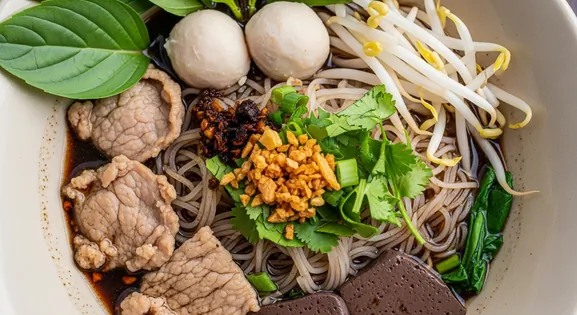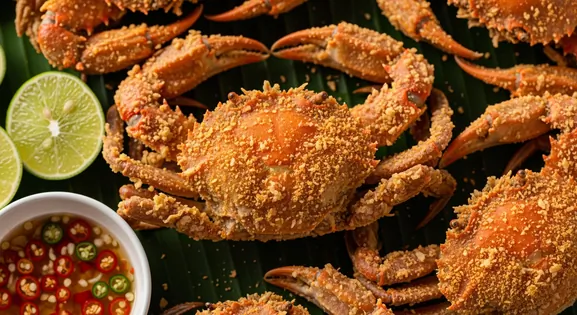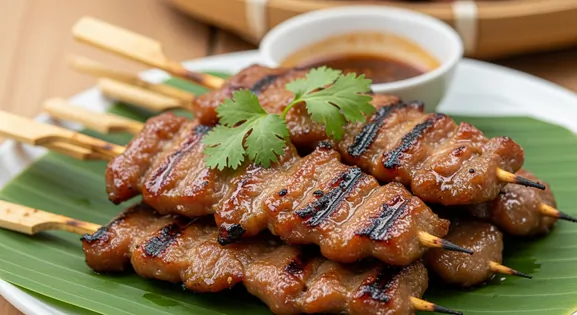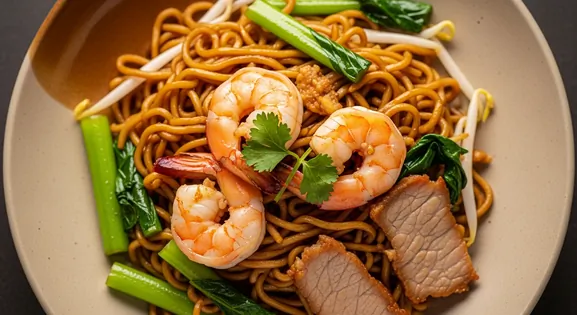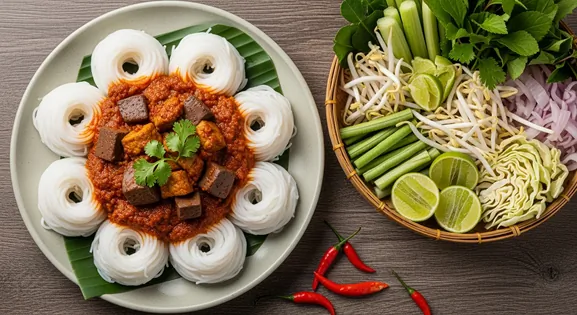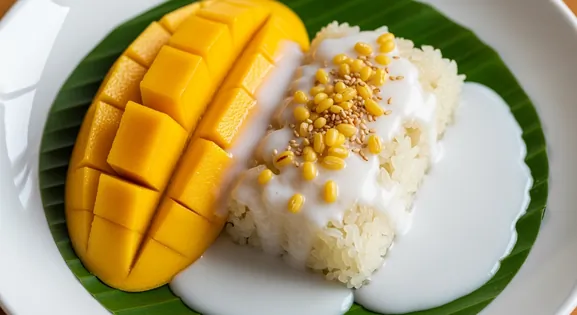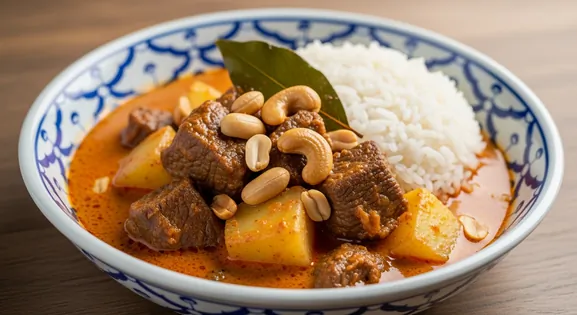Braised Pork Leg in Thailand: A Complete Food Lover's Guide
ขาหมูพะโล้ (Kha Moo Palo)
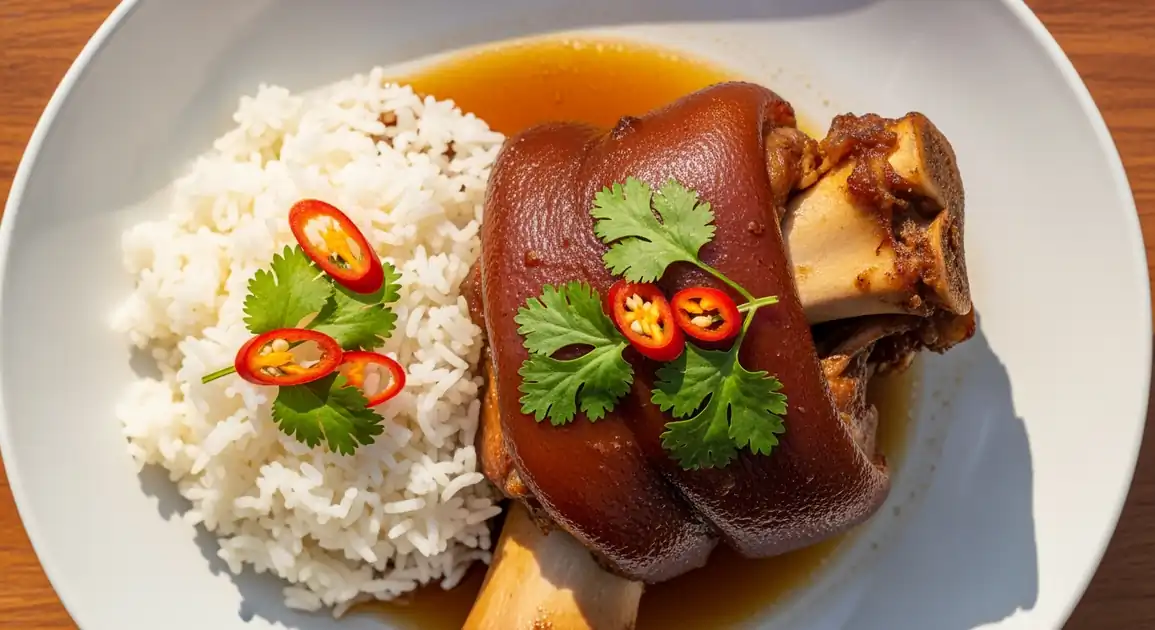
A Culinary Snapshot
Kha Moo Palo is a beloved Thai-Chinese dish featuring pork leg slow-braised in a fragrant mixture of soy sauce, five-spice, star anise, cinnamon, and palm sugar until the meat becomes incredibly tender and infused with sweet-savory flavors. This comfort food staple showcases the cultural intersection of Thai and Chinese culinary traditions, and is widely available from specialized street vendors to established restaurants throughout Thailand.
An Authenticity Checklist
What to Look For
-
Braising liquid maintained at a constant simmer
The braising liquid should be kept hot (not just warm), which ensures food safety and indicates the vendor is continuously cooking throughout the day.
-
Clean cutting boards and utensils
Since the meat is handled after cooking, look for vendors who maintain separate stations for raw and cooked meat, and regularly clean their equipment.
-
Vendor uses fresh ingredients for accompaniments
Quality vendors provide freshly prepared side vegetables and newly cooked rice, not items that have been sitting out for extended periods.
-
Pork is cut to order
Better vendors slice the pork leg right before serving rather than pre-slicing large quantities that sit at ambient temperature.
What to avoid
-
Pre-cut pork sitting at room temperature
Avoid vendors who pre-slice large quantities of pork leg and leave it out, as this can compromise freshness and quality over time.
-
Cloudy, greasy braising liquid
Quality braising liquid should be clear (though dark). Excessive cloudiness may indicate poor maintenance or a lack of freshness in the stock.
-
Unrefrigerated garnishes and sauces
Condiments like chopped garlic in vinegar should be kept cool to ensure their optimal freshness and flavor.
-
Stalls with very low turnover
This is a popular dish; empty stalls might indicate less fresh ingredients or lower quality that locals avoid.
How to Order Braised Pork Leg
Enhancing the Flavor: Classic Pairings
Steamed Jasmine Rice
staple
The fluffy, fragrant jasmine rice is the ideal absorbent base, soaking up the rich, savory-sweet braising liquid and complementing the tender pork.
Spicy Vinegar Dipping Sauce (Nam Jim)
condiment
A tangy, spicy, and garlicky sauce, often made with chilies, garlic, and vinegar, that cuts through the richness of the pork and adds a refreshing kick.
Explore Braised Pork Leg in Detail: City Guides
Discover where to find the best Braised Pork Leg and learn local tips in these cities:
The Culinary Legend of Braised Pork Leg
Braised Pork Leg reflects Thailand's historical Chinese immigration, particularly from the southern regions of China. The dish evolved from Chinese red-braised pork techniques but adapted to Thai palates with local ingredients and flavor preferences. While maintaining its Chinese roots with five-spice and soy sauce elements, Thai versions often incorporate palm sugar for sweetness and pair the dish with Thai condiments like spicy vinegar dipping sauce. It became popular throughout Thailand as comfort food that crosses cultural boundaries.
Crafting the Perfect Dish
Traditional preparation involves cleaning whole pork legs thoroughly before braising. The legs are blanched briefly in boiling water to remove impurities, then transferred to a large pot with soy sauce, palm sugar, cinnamon sticks, star anise, garlic, peppercorns, and five-spice powder. The key technique is slow-cooking for 3-4 hours at low temperature until the meat becomes fork-tender and the collagen-rich skin develops a silky texture. Hard-boiled eggs are often added partway through cooking to absorb the flavors. Quality vendors maintain their braising liquid (master stock) for extended periods, adding depth with each batch.
Key Ingredients of Braised Pork Leg
Pork Leg
Typically the front or hind leg, chosen for its rich collagen and fat content which breaks down into a tender, gelatinous texture during slow braising.
Quality indicator: Look for fresh, plump pork legs with a good balance of meat, fat, and skin.
Five-Spice Powder
A foundational blend of star anise, cloves, Chinese cinnamon, Sichuan peppercorns, and fennel seeds, providing the dish's signature aromatic and warm flavor profile.
Quality indicator: A high-quality blend will have a strong, fresh aroma and balanced notes, not overly dominated by one spice.
Palm Sugar
Used to balance the savory and umami notes of the soy sauce, contributing a subtle, caramel-like sweetness that is characteristic of Thai braised dishes.
Quality indicator: Good quality palm sugar is soft, pliable, and has a distinct, mellow sweetness, not overly refined.
Local Braised Pork Leg Variations in Thailand
Braised Pork Leg Rice
The most common serving style - sliced braised pork leg over rice, often with Chinese kale or mustard greens, braised egg, and a vinegar-chili dipping sauce.
Braised Pork Leg Noodles
Egg noodles served with sliced braised pork leg, along with the braising sauce, greens, and condiments. Often includes wonton dumplings.
Stewed Pork Leg Soup
A brothy variation with more of the flavorful braising liquid, served as a soup with tender pork, boiled eggs, and sometimes Chinese celery or preserved vegetables.
Five-Spice Braised Pork with Rice
A version with more pronounced five-spice flavor, often found in areas with strong Chinese influence.
Crispy Pork Knuckle
A related dish where the pork leg is braised until tender then deep-fried for a crispy exterior. Served with similar accompaniments but usually with a sweet chili dipping sauce.
Dietary Information
Dietary Information
Important Note for Travelers: Your safety is our priority. Below are the common allergens associated with the traditional preparation of this dish. However, recipes and ingredients can vary significantly between establishments. Always confirm all ingredients directly with the food vendor before ordering, especially if you have a severe allergy.
Potential Allergens
Dietary Suitability
Frequently Asked Questions about Braised Pork Leg
What is Braised Pork Leg (Kha Moo Palo)?
Kha Moo Palo is a popular Thai-Chinese dish featuring pork leg slow-cooked in a sweet and savory sauce made with soy sauce, star anise, cinnamon, and palm sugar. The long braising process results in tender meat that falls off the bone, with a rich, aromatic flavor profile. It's typically served over rice with a boiled egg and some blanched Chinese greens.
What's the difference between Kha Moo Palo and Khao Kha Moo?
While both feature braised pork leg, Kha Moo Palo uses a Chinese-influenced five-spice sauce (star anise, cinnamon, soy) for a darker, sweeter flavor. Khao Kha Moo often incorporates more Thai herbs, garlic, and is served with a garlicky chili vinegar sauce. Kha Moo Palo typically includes braised eggs, while Khao Kha Moo usually doesn't.
Is Braised Pork Leg a good choice from street vendors?
Braised Pork Leg is often an excellent choice from street vendors due to its long, slow cooking process. Look for vendors with high turnover, clean operations, and where the braising liquid is kept at a constant simmer. The dish is best enjoyed when served piping hot. Reputable vendors often demonstrate consistent quality and attention to detail.
How healthy is Kha Moo Palo?
Kha Moo Palo is high in protein but also contains significant fat from the pork skin and fatty portions. Much fat renders out during braising. Sodium content is high from soy sauce. Enjoy occasionally, pair with vegetables, and ask for leaner cuts or less sauce to reduce calories and sodium.
Is Braised Pork Leg gluten-free?
Traditional Kha Moo Palo often contains gluten due to the use of soy sauce, which commonly includes wheat. While some Thai soy sauces can be wheat-free, it's difficult to guarantee. If you have celiac disease or severe gluten sensitivity, it's advisable to inquire specifically about the sauce ingredients with the vendor before consuming.
What are the best accompaniments to Kha Moo Palo?
Traditionally served with steamed jasmine rice, blanched Chinese kale or mustard greens, and braised eggs. Many vendors offer a spicy vinegar-garlic-chili sauce (nam jim) to cut richness. Pickled vegetables or fresh chili and garlic also provide flavor contrast.
Expert How-To Guides about Braised Pork Leg
How to Spot a Good Kha Moo Palo Vendor
Learn what visual cues indicate a quality braised pork leg vendor, ensuring you choose a reputable and delicious street food experience.
- Look for vendors with large, simmering pots of dark brown braising liquid that emits a fragrant aroma of star anise and cinnamon.
- Check that the pork appears freshly cut rather than pre-sliced and sitting out.
- Quality vendors have clear, not cloudy, braising liquid and offer visible whole pork legs still cooking.
- Busy stalls with high turnover ensure fresh product and are a good sign of quality.
- The presence of Thai-Chinese elders eating at the stall is often a reliable endorsement.
- Vendors who proudly display how many years they've been in business typically maintain consistent quality.
How to Order the Perfect Portion of Kha Moo Palo
Guidelines for customizing your braised pork leg experience, from choosing your preferred cut to adjusting spice levels and accompaniments.
- Specify your preferred cut – 'Nang' (skin), 'Man' (fatty part), or 'Nuea' (lean meat), or request a mix ('Ruam').
- Request 'Palo long' if you prefer extra braising sauce over your rice.
- Ask for 'Kaidaeng' to include the braise-stained hard-boiled eggs.
- Indicate if you want 'Pad pak' (stir-fried vegetables) on the side.
- Say 'Mai phed' for no chili or 'Phed nit noi' for just a little spice in the accompanying sauce.
Making Smart Choices for Healthier Kha Moo Palo
How to enjoy this rich dish while minimizing excessive fat and calories, making it a more balanced part of your culinary adventure.
- Request 'Nuea lang' specifically for the leaner back portion of the leg.
- Ask for 'Mai ao nang' to avoid the fatty skin if desired.
- Say 'Nam sauce noi' for less braising liquid to reduce sodium intake.
- Request extra vegetables ('Khor pak mak mak') to balance your meal.
- Consider sharing a portion, as servings can be generous.
- Use the accompanying chili vinegar sauce sparingly as it can be high in sodium.
Our Commitment to Quality
At Tasteplorers, our mission is to provide the most accurate and useful travel information in the world. To achieve this, all content on this site is created through our unique editorial framework. We utilize leading AI research tools, guided by our proprietary prompts, and a multi-stage validation process. This entire system is overseen by our editorial team to ensure everything we publish meets our high standards for accuracy, cultural nuance, and practical value for travelers.
Learn more about our Editorial Process and our Mission.
Countries
Explore regions
Europe
Discover Europe's diverse culinary landscape, from Mediterranean flavors to hearty Alpine fare. Learn to navigate markets, decode menus, and eat like a local.
Latin America & Caribbean
Discover the vibrant cuisines of Latin America & the Caribbean. Our expert guide covers everything from Mexican street food to Peruvian ceviche and market tips.
Oceania
Explore Oceania's diverse food scene. Learn about Polynesian earth ovens, Fijian feasts, and the vibrant café culture of Australia and New Zealand.
Southeast Asia
Explore Southeast Asia's diverse food cultures from Thailand to Vietnam. Get expert tips on navigating spice levels, choosing quality vendors, and understanding the rich traditions of the region.
